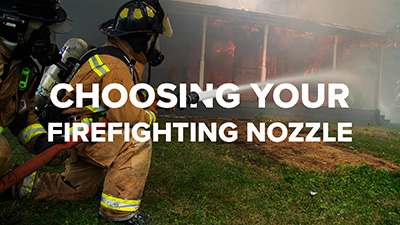How to Choose a Firefighting Nozzle Type
What do you consider before choosing a nozzle type for your firefighting operations? How do you narrow down the choices to get the right tool for the jobs you will face in the future?
It can be tough to know what you need, but it isn’t impossible! Let’s look at the types of firefighting nozzles on the market and what questions you might ask before selecting a nozzle type.
The Four Nozzle Types
There are four main types of firefighting nozzles:
- Smooth Bore Nozzles are the most basic form of firefighting nozzle. They can create a solid stream of water. Smooth bore nozzles are considered a fixed flow nozzle.
- Fixed Flow Nozzles are a type of nozzle that flows a certain amount of water at a specified pressure.
- Selectable Flow Nozzles are another type of nozzle that can flow different amounts of water at a specific pressure based on the nozzle operator’s choice at the nozzle.
- Automatic Nozzles (constant pressure, variable flow) are nozzles that maintain pressure throughout a specified flow range, optimizing reach even under lower flow scenarios.
Combination Nozzles

Some nozzles are combination nozzles. This means they can flow a straight stream pattern and a fog pattern based on the selection made by the nozzle operator in response to their needs on the fire ground. A straight stream is most often used for initial fire attack and fire suppression, while fog patterns can be used for overhaul and hydraulic ventilation.
Smooth Bore Nozzles

A smooth bore nozzle is not capable of a fog pattern. You may find yourself breaking your stream with a smooth bore by gating or half-bailing the nozzle. While this does create a broken pattern it also reduces your flow.
Choosing Your Nozzle Type
When choosing a nozzle type, you need to consider the needs of your department and the calls you typically respond to. Consider the following:
What flow and pressure do you need?
Deciding the necessary flow and pressure for your nozzle can help you figure out which nozzles will meet your needs from different manufacturers. You should consider the types of fires you face regularly, the capabilities of your current equipment, and the hose you plan to use with the nozzle. NFPA 1710 (5.2.4) is a valuable reference and starting point about initial attack fire flows for different types of structures.
What water flow patterns do you need?


You already know that you use different patterns for different results on the fire ground. Before deciding on a nozzle type, think through the types of fires you regularly encounter to decide what patterns you need access to with your nozzle.
If your department regularly responds to scenes that require extensive overhaul or exposure protection, having a fog pattern available is important. If delivery of finished foam is required for your department, a fog pattern is a must for this application as well.
What personnel do you have available?
The type of nozzle you select may depend somewhat on the number of personnel you have available and the training they have under their belts. If you are a volunteer department that struggles with staffing a call, you will likely have people multi-tasking on the scene. You may want to consider a nozzle that will require less communication between the nozzle operator and pump operator.
On the other hand, if you do not have staffing issues, you can look at nozzles with a little more nozzle reaction that may require multiple people to handle the line but will give greater reach and impact force.
Learn more about nozzle reaction with this article.
What level of maintenance does the nozzle require and what is the cost of upkeep?
When you choose a nozzle type, you should consider the required maintenance and ongoing cost of ownership. In general, a smooth bore nozzle requires the least amount of maintenance and upkeep because of its simplicity. This does not mean it is always the best choice, though. Other nozzle types have more moving parts and internal mechanisms to give them their functionality, and this does generally mean more maintenance and more difficult service, however, this also allows them to provide the other functions you may need on the fire ground.
Conclusion
When it comes to choosing your nozzle, you have only a few types to choose from. It is important to fully consider your target flow and pressure rates, personnel availability, patterns you may need, and the cost of upkeep on each nozzle before you make a choice.
